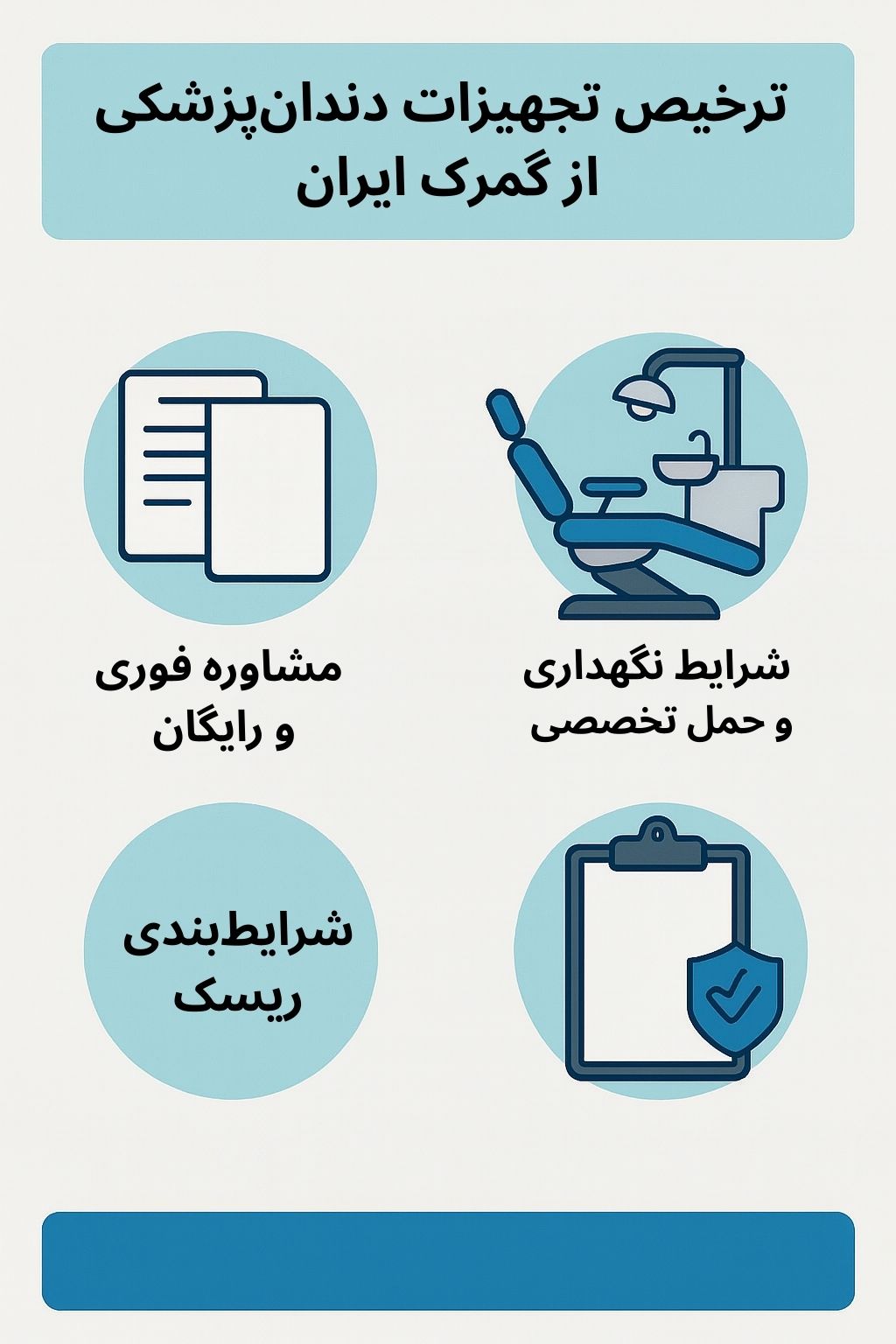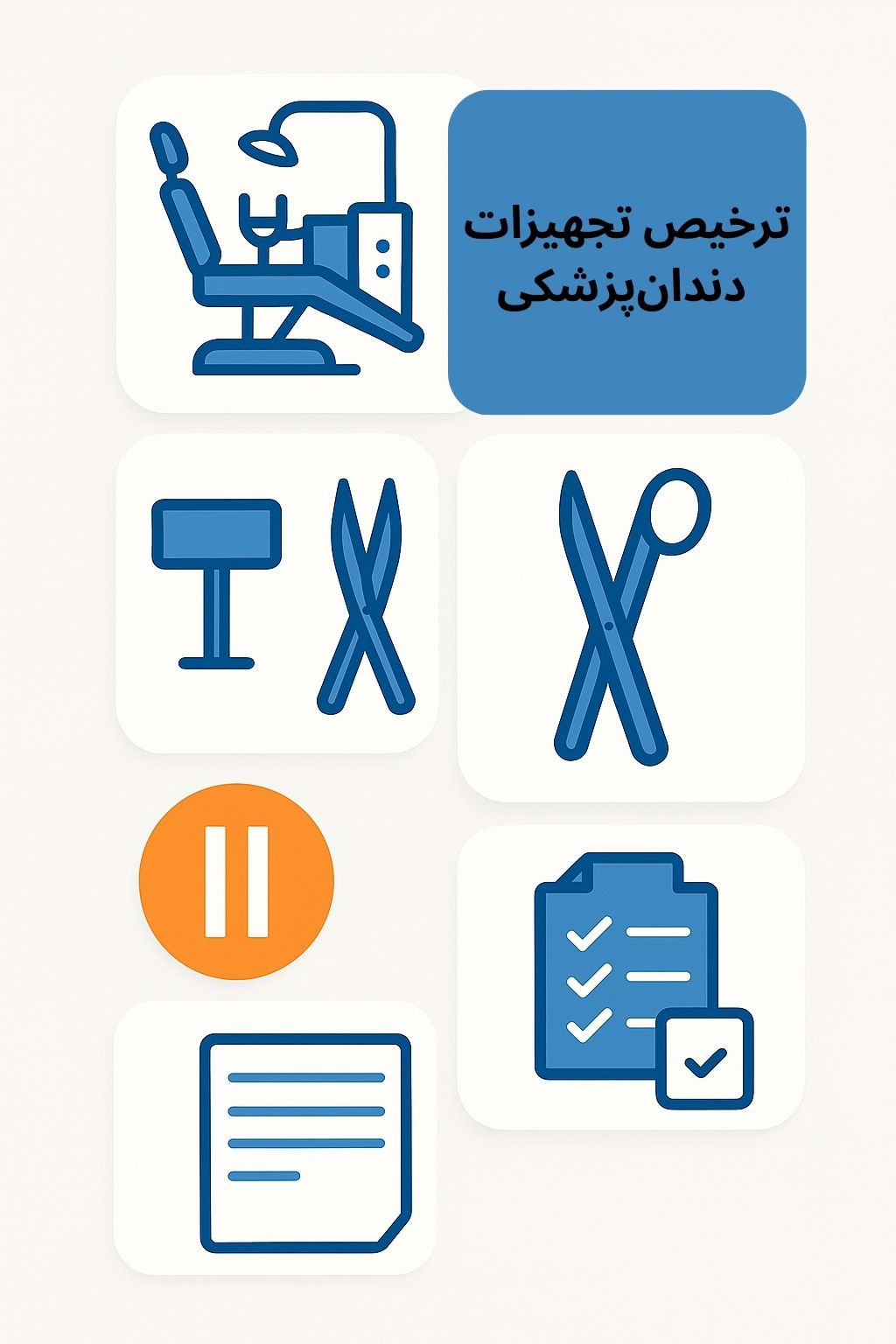Customs Clearance of Dental Equipment in Iran (HS Code + Documents & Permits)
Instant free consultation
Instant free consultation
1) Detailed Description of Dental Equipment
2) Types & Applications of Dental Equipment
Description: includes chair, light, and dental instruments.
Tariff code: 9018.90.10
Description: includes X-ray devices and other imaging equipment.
Tariff code: 9018.90.20
Description: includes instruments for extraction and periodontal surgeries.
Tariff code: 9018.90.30
Description: includes brackets, wires, and other orthodontic tools.
Tariff code: 9021.10.00
Description: includes fillers, cements, and restorative materials.
Tariff code: 3006.10.00
Description: includes sterilization and disinfection devices.
Tariff code: 8422.19.00
Description: includes drugs and materials used for anesthesia.
Tariff code: 3004.90.00
Description: includes laboratory devices for prosthesis preparation and lab work.
Tariff code: 9018.90.40
Description: includes dentures and dental prostheses.
Tariff code: 9021.10.10
Description: includes scanners and 3D printers.
Tariff code: 9018.90.50
3) Key Points in Clearing Dental Equipment
- Health & safety standards: dental equipment must conform to recognized global standards such as CE (European) or FDA (U.S.).
- Customs & health inspections: some dental devices must be inspected by health authorities before clearance to ensure safety and quality.
- Accurate tariff classification: selecting the precise HS code for each device is crucial. Errors can cause clearance issues and increase duties.
- Label/manual consistency: brand, model, serial number, country of origin, and voltage/frequency must match across invoice, packing list, COA/COC, and the device itself.
- Drug/device classification: anesthetics, cements, and some kits fall under Ministry of Health regulations and may use different HS codes.
- EEE & electrical safety: declare power rating; provide electrical safety test certificates and EMC reports for powered devices.
4) Customs Tariff & HS Codes for Dental Equipment
| Item | Short Description | HS Code (Set 1) | HS Code (Set 2) |
|---|---|---|---|
| Dental unit | Chair, light, and unit components | 901849 | 9018.90.10 |
| Dental radiography | X-ray/CBCT | 902213 | 9018.90.20 |
| Autoclave | Steam sterilization | 841920 | 8422.19.00 |
| Dental drill | Handpiece/micromotor | 846729 | 9018.90.30 / 9018.90.50 |
| Orthodontic equipment | Bracket, wire, tools | 9021.10.00 | 9021.10.10 |
| Dental materials | Cement, composite, amalgam | 3006.10.00 | 3004.90.00 (anesthetics) |
Final classification depends on model/application, components, inclusion of consumables, risk class, and technical documentation.
5) Special Conditions for Import & Export
6) Iranian Market: Suppliers & Destinations
7) Trade Volume: Iran & Worldwide
8) Global Market: Major Exporters & Importers

9) Required Documents for Clearance
Issued by the Ministry of Health, Treatment, and Medical Education, confirming that dental equipment complies with health and safety standards. Mandatory for all dental equipment and usually includes item details and necessary approvals for import.
Before any action, your order must be registered in the National Trade System. This step is crucial for legal and procedural tracking.
The sales invoice must include precise information on the type and quantity of equipment, price, delivery terms, and the supplier’s name. The proforma is also commonly used as initial documentation during clearance.
This essential document shows the equipment is insured during transit. It should include item details, transport conditions, and type of coverage.
A document providing exact information on the type of goods, weight, volume, and origin/destination; it plays a key role in identifying and tracking the shipment.
Specifies the country from which the goods are imported and is usually issued by the supplier. Essential for determining customs duties and technical requirements.
Issued by accredited inspection companies, confirming the dental equipment meets necessary standards and quality conditions.
Many dental devices require international certifications, such as CE (European) or FDA (U.S. Food & Drug Administration). These indicate compliance with global standards.
A preliminary invoice in international transactions containing complete information on the goods, price, and sales terms.
Depending on the device type, additional specific certificates may be needed, such as laboratory reports or safety approvals.
Need precise HS code determination, Ministry of Health permits, and documentation preparation? Our team manages your case end-to-end.
Submit pro forma requestKey Tips & Practical Recommendations
- Before purchase, match the proposed HS code with the catalog and device images, and ensure it aligns with the device label.
- For high-risk items, obtain preliminary assessment from the Ministry of Health and request written confirmation.
- Use shock/moisture-resistant packaging and all-risk insurance for sea/air shipments; breakage/water damage are common dispute causes.
- For mixed shipments, separate consumables from capital equipment to keep classification and permitting clear.
Frequently Asked Questions
What permits are required to clear powered dental devices?
Generally, a Ministry of Health permit for applicable items, along with electrical safety/EMC documents and international standards (CE/FDA), is required. Label consistency with shipping documents is critical.
What are the consequences of HS code discrepancies?
They can delay clearance, trigger re-evaluation, and increase import duties. It’s recommended to conduct and document preliminary classification before purchase.
Do all devices require CE or FDA?
Depending on risk class and country of origin, valid certificates are mandatory. In Iran, the Ministry of Health permitting is central, and international documentation supports approval.
What are the minimum documents to start the process?
Proforma/commercial invoice, catalog and device photos, technical specifications, proposed HS code, certificate of origin, insurance policy, and bill of lading. For applicable items, Ministry of Health permit is also required.
Special Services for Clearing Dental Equipment
Special services for clearing dental equipment — Saba Tarkhis Brokerage, with years of experience in customs clearance, offers tailored services for dental equipment. These include:
Specialized consulting: our experts, fully versed in customs and health regulations, provide the best strategies for clearing dental equipment, including accurate tariff classification, obtaining necessary permits, and optimizing the clearance process.
Permit follow-up: securing health and technical permits is a key challenge. Our team meticulously follows up to facilitate clearance and prevent potential delays.
Logistics solutions: in collaboration with reputable carriers, we offer optimal options for fast and safe transport of dental equipment to importers.
Fast, assured clearance: relying on our team’s expertise, we ensure goods are cleared in the shortest possible time and in compliance with all customs and health regulations.
Cost savings: by providing optimized solutions at each stage, we help importers clear their equipment at the lowest possible cost.
Ultimately, these specialized services allow importers to bring in and clear their goods with peace of mind. Leveraging these services not only speeds up clearance but also reduces costs and prevents legal issues.
.png)
